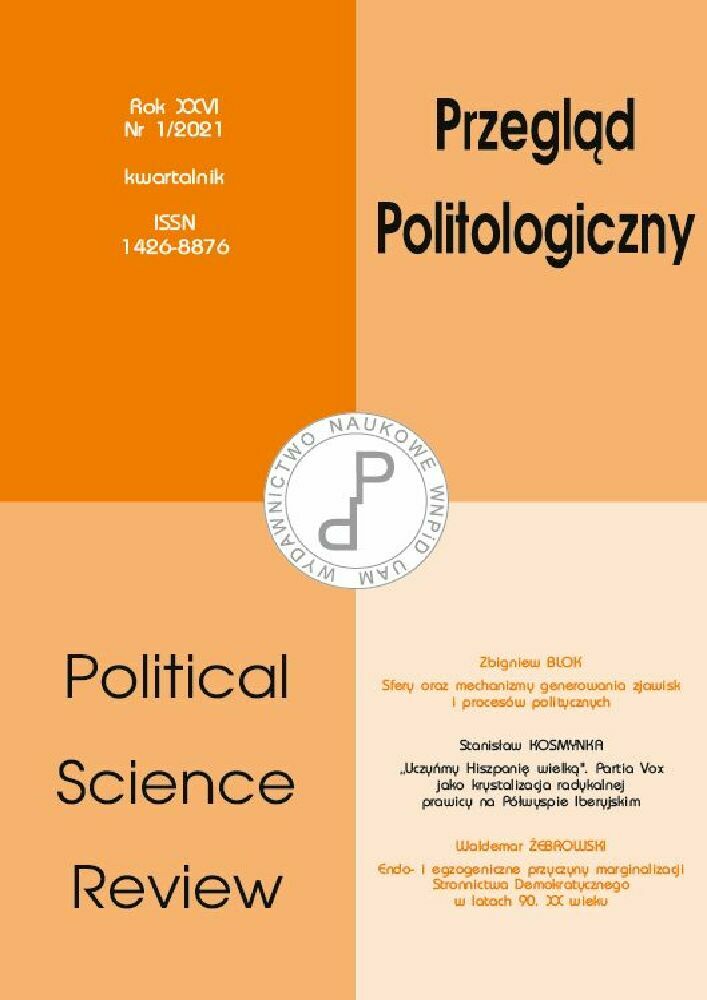Abstract
The aim of the article is to present the opportunities and threats resulting from the implementation of voting via the Internet (i-voting) and to discuss the conditions for effective implementation of this alternative voting procedure on the example of Estonia and Switzerland. Estonia is the only country in the world where i-voting is widely used. In Switzerland, on the other hand, this voting method has been used most often, although its use has been suspended for several years due to legal, infrastructural and political problems. What are the conditions for successfully implementing Internet voting? The attempt to answer this research question was possible thanks to the use of the following research methods: comparative, formal-dogmatic, behavioral and modified historical method. The key conclusion is that the implementation of i-voting must be preceded by many years of political, legal, infrastructural and social activities, and that the created system must be as transparent as possible.
References
Applegate M., Chanussot T., Basysty V. (2020), Considerations on Internet Voting: An Overview for Electoral Decision-Makers, https://www.ifes.org/sites/default/files/considerations_on_internet_voting_an_overview_for_electoral_decision-makers.pdf.
Breuer F., Trechsel A. H. (2006), E-Voting in the 2005 local elections in Estonia, https://www.coe.int/t/dgap/goodgovernance/Activities/E-voting/CoE_Studies/FinalReportCOE_EvotingEstonia2005_en.asp.
Dreschler W. (2003), The Estonian E-Voting Laws Discourse: Paradigmatic Benchmarking for Central and Eastern Europe, https://www.researchgate.net/publication/2858709_The_Estonian_E-Voting_Laws_Discourse_Paradigmatic_Benchmarking_for_Central_and_Eastern_Europe.
Duda K. (2011), E-voting jako forma demokracji bezpośredniej. Dotychczasowe doświadczenia i ich konsekwencje, “Refleksje”, nr 4.
Driza Maurer A. (2014), 5th review meeting of Rec (2004)11 on legal, operational and technical standards for e-voting, https://rm.coe.int/1680597aec.
Dyś-Branicka I. (2016), E-voting jako alternatywna procedura głosowania na przykładzie Estonii – szanse i zagrożenia, http://repozytorium.uni.wroc.pl/Content/79494/PDF/05_01_I_Dys-Branicka_E-voting_jako_alternatywna_procedura_glosowania.pdf.
E-governance, https://e-estonia.com/solutions/e-governance/i-voting.
Election Commision of India, Eci Voting Equipments, https://eci.gov.in/evm/.
Estonian Internet voting, https://ec.europa.eu/cefdigital/wiki/display/CEFDIGITAL/2019/07/29/Estonian+ Internet+voting.
Estonian Internet Voting System, Estonian Ministry of Foreign Affairs, https://vm.ee/sites/default/files/content-editors/2015%20Parliamentary%20elections%20Internet%20voting%20system.pdf.
Estonia’s Mobile-ID: Driving Today’s e-Services Economy, https://www.gsma.com/identity/wp-content/uploads/2013/07/GSMA-Mobile-Identity_Estonia_Case_Study_June-2013.pdf.
E-Voting, https://www.bk.admin.ch/bk/en/home/politische-rechte/e-voting.html.
Evoting by CHVote, https://www.ge.ch/document/evoting-chvote/telecharger.
E-voting. Online voting and elections, https://www.post.ch/en/business-solutions/e-voting/legal-basis.
Federal Act on Political Rights, https://www.admin.ch/opc/en/classified-compilation/19760323/index.html.
Galano J. (2019), i-Voting – the Future of Elections?, https://e-estonia.com/i-voting-the-future-of-elections/.
Germann M., Serdült U. (2017), Internet voting and turnout: Evidence from Switzerland, “Electoral Studies”, v. 47.
Gibson P. J., Krimmer R., Teague V., Pomares J. (2016), A review of E-voting: the past, present and future, “Annales of Telecommunications” 7.
Grodzka D. (2009), E-demokracja, Biuro Analiz Sejmowych. INFOS Zagadnienia społeczno-gospodarcze nr 14.
Introducing Electronic Voting: Essential Considerations (2011), PolicyPaper, https://www.idea.int/sites/default/files/publications/introducing-electronic-voting.pdf.
Jakubiak Ł. (2010), Kantonalne zgromadzenia ludowe w Szwajcarii, „Ruch Prawniczy, Ekonomiczny i Socjologiczny”, rok LXXII, z. 4.
Krasnowolski A. (2016), Referendum jako instytucja demokracji bezpośredniej w państwach europejskich, https://www.senat.gov.pl/gfx/senat/pl/senatopracowania/139/plik/ot-643_do_internetu.pdf.
Kulikowska M., Epa E. (2015), Perspektywy uregulowania powszechnego dostępu do Internetu i elektronicznego głosowania w Polsce, Studia z Zakresu Nauk Prawnoustrojowych. Miscellanea, t. 5.
Kużelewska E. (2017), Landsgemeinde – demokracja na świeżym powietrzu. Czy głosowanie jawne nadal ma sens?, „Political Preferences”, vol. 15.
Landsgemeinde, https://www.appenzell.ch/de/kultur-und-braeuche/braeuche-und-traditionen/landsgemeinde.html.
Landsgemeinde vom Sonntag, 6. September 2020 (2020), https://www.landsgemeinde.gl.ch/landsgemeinde/2020.
Madise Ü., Vinkel P. (2011), Constitutionality of Remote Internet Voting: The Estonian Perspective, “Juridica International” XVIII.
Mider D. (2011), Głosowanie przez Internet a demokracja, „Studia Politologiczne”, t. 20.
Nowina Konopka M., Elektroniczna urna, Elektroniczna urna, https://www.rpo.gov.pl/pliki/12066058070.pdf.
Musiał-Karg M. (2010), Głosowanie elektroniczne – nowe wyzwanie dla demokracji?, „Przegląd Politologiczny”, nr 4.
Musiał-Karg M. (2012), Elektroniczne referendum w Szwajcarii. Wybrane kierunki zmian helweckiej demokracji bezpośredniej, Wydawnictwo Naukowe WNPiD UAM, Poznań.
Musiał-Karg M. (2015, Nowe technologie w procedurach wyborczych. Uwagi na temat bezpieczeństwa elektronicznego głosowania, „Przegląd Naukowo-Metodyczny. Edukacja dla Bezpieczeństwa”, nr 4 (29).
Musiał-Karg M. (2018), Analiza doświadczeń związanych z wykorzystaniem głosowania internetowego (i-voting) w wybranych państwach, „Zeszyty Prawnicze Biura Analiz Sejmowych Kancelarii Sejmu”, nr 1(57).
Plantera F. (2019), When will other countries join Estonia in voting on the internet?, https://e-estonia.com/when-will-other-countries-join-estonia-in-voting-on-the-internet/.
Prime Minister of Estonia explains how fast, simple and safe is e-voting, https://www.youtube.com/watch?v=yZ4s95lFkk4, 28.07.2020.
Rulka M. (2015), Orzecznictwo dotyczące konstytucyjności regulacji umożliwiających głosowanie elektroniczne (Niemcy, Austria, Estonia, Indie), „Przegląd Sejmowy”, nr 6(131).
Serdült U. (2019), Switzerland: I-voting and direct democracy, http://agendapublica.elpais.com/switzerland-i-voting-and-direct-democracy.
Shvaikovsky O. (2020), i-Voting could save the democracies of the world, https://nortal.com/blog/i-voting-could-save-the-democracies-of-the-world.
Skotnicki K. (2018), Instytucja i-votingu w wybranych krajach, „Zeszyty Prawnicze Biura Analiz Sejmowych Kancelarii Sejmu”, nr 1(57).
Susha I., Kripp M. J. (2011), How to successfully implement internet voting? Strategic recommendations on overcoming remote e-voting challenges, Working Paper Series on Electrionic Voting and Electronic Participation, nr 1.
United Nations General Assembly (2016), The promotion, protection and enjoyment of human rights on the Internet, https://www.article19.org/data/files/Internet_Statement_Adopted.pdf.
Vinkel P. (2012), Internet Voting: Experiences From Five Elections in Estiona, https://www.researchgate.net/publication/281348221_Internet_Voting_Experiences_From_Five_Elections_in_Estonia.
Weder C. (2020), Keine Landsgemeinde, dafür ein Urnengang im August – Innerrhoder Landammann: «Die Absage tut weh», https://www.tagblatt.ch/ostschweiz/appenzellerland/dem-coronavirus-geschuldet-keine-landsgemeinde-im-kanton-appenzell-innerrhoden-im-jahr-2020-ld.1222564.
What is e-voting?, https://www.ch.ch/en/demokratie/voting-online/what-is-e-voting/.
Zbieranek J. (2018), Głosowanie przez internet (i-voting) w wybranych państwach, „Zeszyty Prawnicze”, nr 1(57).

